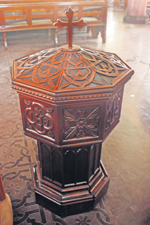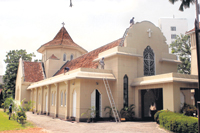|
|
|||||
|
When St. Luke’s bells first rang out
It was on June 30, 1881 that the church bells of St. Luke’s first rang to announce that worship was about to begin. Horse drawn traps brought people from in and around Borella to congregate at the little church, lit by gas lamps. The organ played as the choir took its place and people reverently made their way into the pews. “Rev. Ireland Jones preached the first sermon at the church’s dedication,” says parishioner Jean Brohier. She and other elders who have worshipped there for generations have attempted to trace the beginnings of their church, one of the earliest Anglican churches built during the colonial era that celebrates its 125th anniversary today.
Research by Council Member of the Royal Asiatic Society and Vice President Ceylon Society of Arts, Frederick Medis reveals fascinating details. St. Luke’s Church Borella apparently was an initiative of Dr. J.L. Vanderstraten (MD) who was keen to see a house of worship for the growing community of Christians of all four ethnic communities as well as colonists in the area. A prominent paediatrician, Dr. Vanderstraten set about forming a committee and as treasurer launched a campaign to raise the estimated amount of Rs. 12,000, a formidable sum at the time. Construction began, soon after half the targeted amount was collected. Interestingly, the two acre plot of land in Borella was purchased for 600 sterling pounds. Situated in a naturally reclaimed swamp area that was marshy, a good part of the church compound had to be filled. The foundation stone was laid on October 8, 1880 and over the next nine months the building was completed. Along simple lines, the original church was Gothic in structure, characterised by strong vertical lines, high vaulted ceilings, minimal wall space, pointed window and door openings and buttressed walls. Although designed and supervised by a colonial architect, the construction labourers (carpenters and masons) were locals probably from Moratuwa, who had worked previously with other colonists. That the church was called St. Luke’s after the physician/evangelist disciple of Jesus Christ was appropriate, according to another parishioner George Reed. He notes the church that then belonged to the Kotte Mission was in the vicinity of Christian schools, hospitals and residences of medical professionals. Healing thus became an essential ingredient in their ministry.
From 1895 to 1928 services were conducted in Tamil and Sinhala too, with the help of clergy from Kotte, Galle Face and the Diocese. The first congregations, Mr. Reed says, comprised students from the two Christian Missionary Society boarding schools on Ward Place and Rosmead Place and from the nearby hospitals. Gradually members from the Union Church on Rosmead Place and other churches further away found it more convenient to attend this church and the congregation grew. In 1895, Rev. G.T. Fleming who ministered to the Tamil congregation appealed for funds. With Rs. 1250 that they raised they were able to construct the Fleming Hall that housed church meetings and the Sunday school, Mr. Medis’s paper further states. Details of the church’s activities and the various clergy that shepherded the church thereafter are sketchy. Significantly, sixty years later, around the time of the Second World War the parish saw increased activity. Appointed to the parish in 1929, Rev. H.V. Ivan S. Corea, made plans for renovations as the congregation had outgrown the building. “He was the longest reigning priest of the church and he personally drew the designs,” Ms. Brohier marvels. While retaining all the early features, the arches took the shape of lotus petals and the roof, the typical Kandyan Sinhala hat shape (octagonal tower of the sanctuary), a blend of Western and Eastern architectural styles, Mr. Reed pointed out. The new church that became a landmark building was consecrated on June 30, 1941. Today, the baptismal font, the pulpit and the
memorial plaques of early parishioners such as John de Melho (29.10.1831
to 29.3.1891 Proctor – Supreme Court) amongst others still
remain, as testimony to the early church. In the early years the church also offered hospital chaplaincy and conducted a healing mission headed by Bishop Dr. Pakenam Walsh. To honour the church’s namesake, services were held for those working in the medical field. The early morning services at 5.30 were attended by medical practitioners before reporting for duty. Ms Brohier and Mr. Reed speak with pride of the traditions passed down from the early days that continue with equal fervour – the mixed choir that featured several times on Radio Ceylon those days, the 180 student strong Sunday school, the Bible quizzes, night vigils, festival of choirs and feeding of the poor. The elders’ home in Nawala is currently run by this parish. In 1982, family camps were initiated that grew into a mission with other churches in 1986. St. Luke’s, it appears has always been a welcoming community of people learning to worship God, love one another and serve all people. As they complete 125 years, their mission remains strong. However, considering the current situation in the country, the celebrations will be on a low key. The Mission that was held from June 30 to July 1 observed the theme: Retaining God’s Glory in Life and Mission.
|
|||||
Copyright © 2006 Wijeya Newspapers
Ltd. All rights reserved. |

